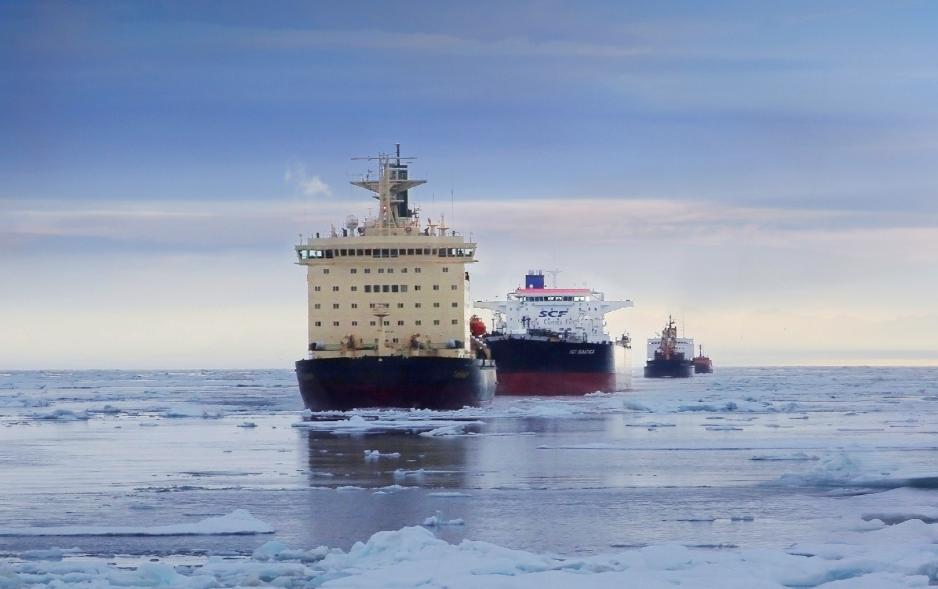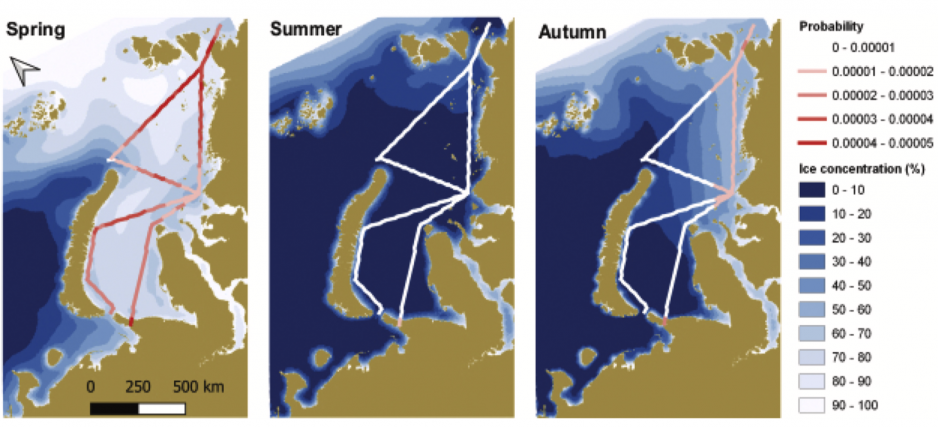New Study Calculates Risk of Vessels Becoming Stuck in Arctic Sea Ice

Vessels being escorted along the NSR by icebreaker. (Source: Sovcomflot)
A new study sheds light on some of the risks associated with Arctic shipping finding that vessels with lower ice-classes are up to 20 times more likely to become stuck in sea ice along Russia’s Northern Sea Route than vessels with higher levels of protection. The study’s authors hope that their work will improve safety of navigation in the Arctic.
Over the past decade shipping traffic in the Arctic has expanded rapidly, especially along Russia’s Northern Sea Route (NSR), which has seen a ten-fold increase in cargo volume over the past decade. As Arctic sea ice recedes as a result of climate change, more and more vessels with low ice-class are venturing into the region.
A new study aims to provide answers on how much riskier Arctic navigation is for ships with limited ice protection.
Ships traveling in the Arctic’s ice-infested waters face a host of hazards, including striking hardened multi-year ice, ice buildup on the ship’s surface structures, remoteness, and difficult weather conditions.
Among the most serious hazards is becoming surrounded and stuck in sea ice requiring the assistance of other vessels, such as an icebreaker, to break free. A new study published in Cold Regions Science and Technology by Finnish researchers uses historical data and mathematical models to quantify the risk of vessels becoming stuck, or beset, in sea ice.
When vessels become beset in ice, pressure on the ship’s hull, so-called ice-loading, can increase causing severe structural damage. Structural damage as a result of becoming beset in ice can lead to oil spills and are a significant environmental threat from Arctic shipping.
The entrapped ship can also drift towards shallower waters resulting in grounding, endangering its crew, passengers, or cargo.
Using data to calculate risk
The study tracked vessels using their Automatic Identification System (AIS) data – a tracking system using GPS – and overlaid their paths with satellite-based ice data. The researchers then collected data on real-life besetting events along Russia’s NSR. For the period between 2013-2017 the research identified 58 besetting events.
The lower the Polar Ship Category, the higher the probability that a ship experiences a besetting event.
Besetting events can trigger major rescue operations requiring powerful nuclear icebreakers. In January of 2021 the NSR saw a three-week long rescue operation requiring several icebreakers to free a cargo ship beset in early-winter ice.
The researchers included a number of variables in their study, including the vessels’ ice class, the time of year (spring, summer, and fall), sea ice concentration, the distance the ships traveled, and the geographic area along the NSR (Laptev Sea, Kara Sea, and East Siberian Sea).
The study used three different types of ice-class protection (low, medium, and high) and two different levels of sea ice concentration (60-70% and 90-100%) to calculate the probability of a ship becoming beset in ice during the spring, summer, or fall over a given distance.
The analysis shows that a vessel’s ice class and the level of sea ice concentration are the two most important factors in determining the probability of a ship becoming beset in ice.
Interestingly, according to the researchers, the risk of becoming stuck in sea ice did not increase based on the geographic area, such as the East Siberian Sea which is known for challenging ice conditions.
“The lower the Polar Ship Category, the higher the probability that a ship experiences a besetting event. [However] there is no noticeable difference in besetting event rates between the Laptev Sea, the Kara Sea and the East Siberian Sea,” the researchers conclude.

The expected probability of becoming stuck in ice for a high ice-class vessel along different navigation routes in the Kara Sea in spring (March-June), summer (July- September) and autumn (October-November). (Source: Jarno Vanhatalo et al.)
Most risk for low ice-class and high ice-concentration
While the probability of a besetting event for high ice-class ships, such as modern ice-breaking natural gas or oil carriers, is very low, the risk increases substantially for vessels of medium and low ice-class.
For example, the study concluded that over a distance of 3000 nautical miles in 90–100% ice concentration, the probability of a besetting event for a ship with a low-ice class is about three times as high as for a ship with a medium ice-class and approximately 20 times higher than for a ship with a high ice-class.
Furthermore, the risk of becoming stuck increases for all types of vessels the denser the ice is. An increase from 60 to 70% to 90–100% ice concentration can double the probability of a besetting event.
The study’s authors suggest that their new research may help inform future risk analysis and risk management of Arctic shipping, taking into account the interplay of multiple factors such as a vessel’s ice-class and sea ice concentration.

